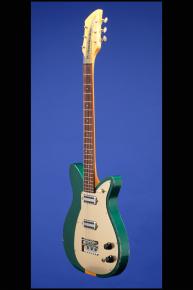Exceptionally Rare First Edition, Second Issue, 1957 Cloverfield Green Rickenbacker Combo 450
This super-rare, factory 'Cloverfield' Green, 13-inch-wide guitar with a tulip-shaped body (the offset cutaways both curve out, but the thicker left horn provides an uneven "tulip" shape) weighs just 6.30 lbs. and has a nice fat nut width of 1 11/16 inches and a scale length of 25 inches. Double cutaway maple body with neck-through-body construction. One-piece maple neck, Brazilian rosewood fretboard with 21 medium-to thin frets and white dot position markers. Serial number "4C7 424A" stamped onto circular metal strap-pin retainer on back of bass-horn. Headstock with gold-colored, crescent-shaped, anodized metal logo plate lettered in black "Rickenbacker" and secured with three screws. Individual Grover open-back tuners with clover-leaf shaped metal buttons. Two Rickenbacker 'Toaster' Single-Coil pickups, both with two height-adjustment screws and outputs of 2.85k. Gold-colored anodized metal pickguard with nine screws. Original 'Tulip-shaped' single-layer white plastic back-plate secured by thirteen pins. Two controls (one volume, one tone) plus three-way pickup selector switch and jack socket, all on pickguard. The potentiometers are stamped stamped "140 706" (Clarostat, February, 1957). Black bakelite seven-sided control knobs with white marker-line on top. Rickenbacker individually adjustable six-saddle bridge with four height-adjustment screws which in turn sits on Rickenbacker aluminum tailpiece secured by three screws. Complete with the original gold-colored anodized bridge cover. There is a small amount of wear to the body edges, but otherwise this exceptionally rare forty-one year old 'Custom-Color' Ricky is in exceptionally fine (9.00) rating. Housed in the original Rickenbacker grey hardshell case with black leather ends and red plush lining (8.75).
This guitar is similar to the 1957 'Trade Show' examples shown in color on p. 108 of Richard Smith's The History of Rickenbacker Guitars.
"The first Combo 450, introduced in 1957, was a two pickup version of the Combo 400. It was available in the same colors as the 400. The company maintained several variations of the 450 over the years before it was deleted from the guitar line in 1984. The 1957 Combo 450 had the tulip body with neck-through-body construction. Two long bolts and glue connected the outside sections of the body to the center neck/body section. The controls included a rotary selector swith with a plastic pointer knob and black plastic knobs for the volume and tone. Mr. Hall revised the original wiring of the two pickup solid bodies in late 1957. The new control setup (three way pickup selector switch) allowed the player to switch from rhythm to lead, and vice versa, with a minimum change in volume." (Richard R. Smith, The History of Rickenbacker Guitars, p. 143).
According to Richard R. Smith (p. 236), at total of just 90 450's were shipped from the factory during that single year of production, in the following colors: 23 Autumnglo; 45 Black; 21 Cloverfield Green; and 1 with no color specified.
"The new solid body guitars showed Rickenbacker's energy and enthusiasm. They integrated exciting visual designs with the requirements of practical musical instruments. And the designs were original, not copies of Gibson, Gretsch or Fender. The first Combos were just a taste of the new direction the company headed, trailblazing philosophies of guitar technology and construction. Rick solid bodies combined several significant innovations. The extreme cutaway, first used on the Combo solid bodies, combined a flare for style with a concern for utility. Neck-through-body construction, used on most models between 1957 and 1970, was the ultimate manifestation of the solid guitar. With these Rickenbackers, there were no bolts or glue joints on the plane between the end pin and peghead. The design enhanced the instrument's tone and sustain." (Richard R. Smith. The Complete History of Rickenbacker Guitars, p. 138).
Translate:












